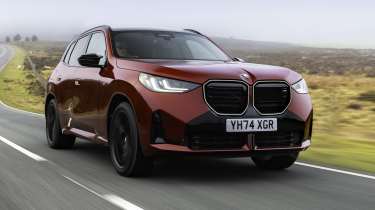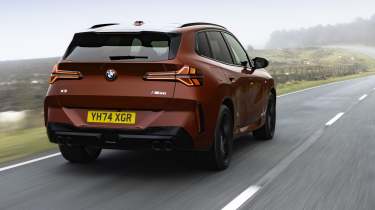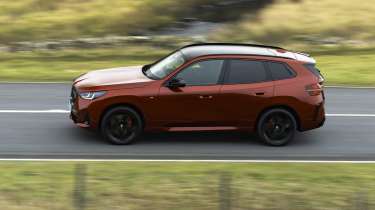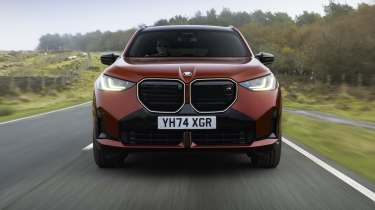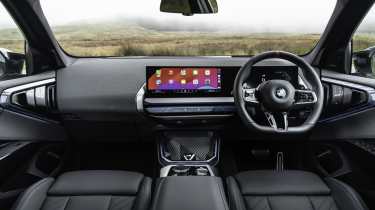BMW X3 M50 2025 review – 393bhp six-cylinder SUV previews the X3 M
The new, fourth-generation BMW X3 has arrived, with the B58-powered M50 leading the pack (for now)
Larger than the original X5 and with a divisive new design inside and out, it seems like a lot has changed with the new, fourth-generation BMW X3. While that’s not entirely wrong, this range-topping M50 variant is refreshingly familiar with its six-cylinder B58 powertrain, and at £68,480, it’s well priced next to rivals such as the equivalent Audi Q5 and Mercedes-Benz GLC too.
The M50 nameplate was previously reserved for V8 models, but BMW felt this X3 deserved to ditch the ‘40i’ badge given the performance on offer. This is the most powerful current B58-powered BMW, so it’s been given design tweaks in-line with this. Its old 40i predecessor went with two trapezoidal exhaust exits, but this model now goes for quad exits akin to a full-fat M, just like the new M135 – BMW says M cars have a more distinctive design than ever, allowing it to make ‘M-lite’ cars unique.
> BMW iX 2025 review – schooling the Tesla Model X on innovation
As with the standard BMW X3, the M50’s design is clean and more grown up than the cars that came before it – at first glance it looks more like a BMW X5. While it’s longer and wider than before, it’s lower than the previous car, with its upright front end (and questionable illuminated grille) making for strong road presence.
Engine, gearbox and 0-62mph time
While the rest of the X3 range now makes do with four-cylinder power, the M50 receives the most powerful B58 six-cylinder powertrain produced. As if it wasn’t capable enough in its basic form, it’s been given 48V mild-hybrid assist here, raising peak output to 393bhp and 428lb ft of torque. Stack those figures up against its rivals and it fares well, with the most powerful standard Audi Q5 producing just 295bhp, and Mercedes-Benz extracting 355bhp from its hybrid GLC 300 e – even Audi’s much more expensive 362bhp SQ5 can’t match the X3 M50, with only AMG beating its output with the 429bhp GLC 43, albeit for a £4700 premium.
More reviews
Reviews
- BMW X3 M50 2025 review – 393bhp six-cylinder SUV previews the X3 M
- BMW X3 M Competition 2022 review
- BMW X3 M40d 2022 review – a compelling alternative to an Audi SQ5?
- New BMW X3 diesel review - 20d and 30d SUV duo driven
- BMW X3 M40i review
- BMW X3 review
- BMW X3 review - strong engines help make this an impressive SUV
All-wheel drive, automatic and with plenty of power on offer, the X3 range-topper manages a quoted 4.6sec 0-62mph time, quicker than the 4.8sec of the more powerful GLC 43 and just a tenth behind the Audi SQ5. On the road it feels as quick as the numbers suggest and more, with the hybrid assist filling the (admittedly small) gaps its torque-rich 3-litre turbocharged straight-six leave for smooth, seamless pull.
A few years ago you could have been convinced this was a full-fat M car, as far as the powertrain is concerned, but compare it to current M offerings and it feels as if it’s being held back. Shifts are smooth and swift, but at full throttle they lack the satisfying push of an M car, with top end pull noticeably less extreme – downshifts also lack the urgency of a thoroughbred performance model, but then that’s not what this is designed to be. It’s a quick car regardless, and it produces a satisfying six-cylinder sound to go with it, something we certainly shouldn’t take for granted in 2025.
Knock the drive mode back to efficient and the X3 M50 switches character, using its low-slung torque for silky power delivery to make everyday drives comfortable and stress-free – the powertrain’s character and sound isn’t dissimilar to a large displacement torque-rich diesel. Drive it back-to-back with the four-cylinder X3 20 and it’s a much more relaxed affair, with this powertrain more than suitable for the task at hand, never feeling overworked.
The calibration of the hybrid assistance is seamless, with engine-off low speed rolling and various other efficiency measures helping it achieve an impressive 35mpg combined over 400 miles of driving – you could extract more if you really wanted to.
Ride and handling
In the context of modern performance cars and the M5’s eye-watering c2500kg kerb weight, the X3 M50’s 2055kg figure seems comparatively featherweight, but there’s no denying this is a big car. As BMW has done elsewhere in its lineup though, it disguises this weight well, with strong body control and the X3 M50 inspiring confidence to push on.
While it’s quick from point-to-point, it’s not particularly engaging. Steering is light and lacking in feel in all of its modes (though its turning circle is unusually good), with Sport mode only marginally increasing heft. Optional adaptive M suspension is a must-have option as ride is firm otherwise, but it doesn’t crash over bumps like some cars in this class and is more than refined enough for everyday driving and motorway miles.
Engage with the eight-speed automatic transmission and you won’t quite get the same response as in full-fat M cars, but you do receive their enlarged, rubberised shift paddles. Leave it in auto and transmission maps are appropriately matched to each mode, if you can find the one you’re looking for – BMW has gone down the path of blending drive modes with ‘experiences’, meaning many of the available modes change more about the ambient lighting and sunroof position than the way the car drives.
Interior and tech
Illuminated kidneys grilles aside, the X3’s new interior is the most divisive design change. The overall aesthetic is much more modern than before, with the passenger side of the dash’s plain and unusual triangular design elements built into equally-minimalist door cards. These incorporate controls for the air vents (which also happen to be in the door cards), the door handles and large, translucent trim pieces backlit to match the ambient lighting. It's these elements that are most controversial, as while the lighting effect is impressive at night (if you're into that sort of thing), they look a little cheap in the daytime.
Materials are good for the most part, with a premium textured fabric used for the door cards in our test car, but some elements feel cheaper than you’d expect. The door-mounted window control panel and grab handle are made from an unusually cheap plastic, although the M50 does receive uprated piano black switches as opposed to the cheaper matt plastic kind in the standard car. The damping on the indicator stalk is also not up-to-par with some rivals at this price point, with a squeaky steering wheel rocker button knocking the premium feel too.
As with most modern BMWs at this price point, the X3 M50 receives the latest OS 9 operating system, projected across a 12-inch central display and 10-inch curved digital dash. This system remains one of the quickest and sharpest on the market, which goes at least some of the way to making up for the distinct lack of physical controls. All of the X3 M50's central controls are capacitive and on flush pieces of glass, which means bright glare can make controls virtually impossible to find.
There are positives, though, with the full-length sunroof a great option to have, vastly improving the experience for rear seat passengers and boosting the sense of interior space. There’s a good amount of usable storage throughout the cabin too, and touches such as the geometric design of the third steering wheel spoke are neat. The M50 also gets a red 12 o’clock marker on the steering wheel along with M sport stitching, reminding you why you spent that additional cash.
Price, specs and rivals
The £68,480 BMW X3 M50 is quite a unique offering in 2025, with many of its rivals straying away from larger displacement engines and downsizing to meet emissions regulations instead. You’ll have to pay a £19,000 premium over the entry-level X3, but we think it’s worth it, with the M50 offering a great blend of performance and practicality for the money.
Skim through Audi's current lineup and you'll find there's no direct alternative to the X3 M50, with the most potent standard Q5 the £55,810 Sport 50 TFSI e quattro with 295bhp – jump up to the SQ5 and power is still some way off the X3 M50 at 362bhp, but you'll pay £75,180 for the privilege, over £8000 more than the BMW. Things are a little better for Mercedes-Benz with the £58,860 GLC 300 e 4MATIC managing a combined 355bhp output from its petrol hybrid powertrain The 429bhp Mercedes-AMG GLC 43 eclipses the X3’s output by quite some margin, but costs considerably more at £73,190.
